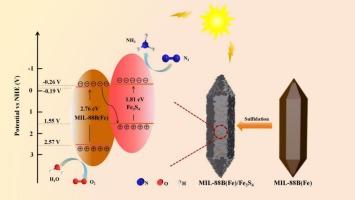Highly efficient photocatalytic nitrogen fixation using in situ sulfurized Z-scheme MIL-88B(Fe)/Fe3S4 heterostructure
IF 9.7
1区 化学
Q1 CHEMISTRY, PHYSICAL
引用次数: 0
Abstract
The photocatalytic nitrogen reduction reaction (NRR) represents a promising green pathway for ammonia synthesis under ambient conditions, offering a sustainable alternative to the energy-intensive Haber-Bosch process. Despite the potential of this approach, conventional photocatalysts often suffer from rapid charge recombination and inefficient N2 adsorption/activation, which significantly limits their performance. To address these challenges, we herein report a controlled in-situ sulfurization strategy to construct a highly active MIL-88B(Fe)/Fe3S4 heterojunction. The in-situ sulfurization process ensures uniform distribution of the sulfur species within the composite, while the intimate interfacial contact between MIL-88B(Fe) and Fe3S4 facilitates efficient charge separation and transfer. The optimized catalyst demonstrates a remarkable photocatalytic nitrogen fixation rate of 68.57 μmol g−1 after 2 h of irradiation, significantly outperforming both pristine MIL-88B(Fe) and Fe3S4 components. This work elucidates the critical role of the in-situ sulfurized Z-scheme MIL-88B(Fe)/Fe3S4 heterostructure in enhancing photocatalytic nitrogen fixation, providing a viable strategy for the rational design of highly efficient and durable NRR systems.

原位硫化z型MIL-88B(Fe)/Fe3S4异质结构的高效光催化固氮
光催化氮还原反应(NRR)代表了在环境条件下合成氨的一个有前途的绿色途径,为能源密集型的Haber-Bosch工艺提供了一个可持续的替代方案。尽管这种方法具有潜力,但传统的光催化剂往往存在快速电荷重组和低效率的N2吸附/活化的问题,这极大地限制了它们的性能。为了解决这些挑战,本文报道了一种可控的原位硫化策略,以构建高活性的MIL-88B(Fe)/Fe3S4异质结。原位硫化过程保证了复合材料中硫种的均匀分布,而MIL-88B(Fe)和Fe3S4之间的密切界面接触促进了有效的电荷分离和转移。优化后的催化剂在照射2 h后的光催化固氮率为68.57 μmol g−1,明显优于原始MIL-88B(Fe)和Fe3S4组分。本研究阐明了原位硫化z型MIL-88B(Fe)/Fe3S4异质结构在增强光催化固氮中的关键作用,为合理设计高效耐用的NRR系统提供了可行的策略。
本文章由计算机程序翻译,如有差异,请以英文原文为准。
求助全文
约1分钟内获得全文
求助全文
来源期刊
CiteScore
16.10
自引率
7.10%
发文量
2568
审稿时长
2 months
期刊介绍:
The Journal of Colloid and Interface Science publishes original research findings on the fundamental principles of colloid and interface science, as well as innovative applications in various fields. The criteria for publication include impact, quality, novelty, and originality.
Emphasis:
The journal emphasizes fundamental scientific innovation within the following categories:
A.Colloidal Materials and Nanomaterials
B.Soft Colloidal and Self-Assembly Systems
C.Adsorption, Catalysis, and Electrochemistry
D.Interfacial Processes, Capillarity, and Wetting
E.Biomaterials and Nanomedicine
F.Energy Conversion and Storage, and Environmental Technologies

 求助内容:
求助内容: 应助结果提醒方式:
应助结果提醒方式:


